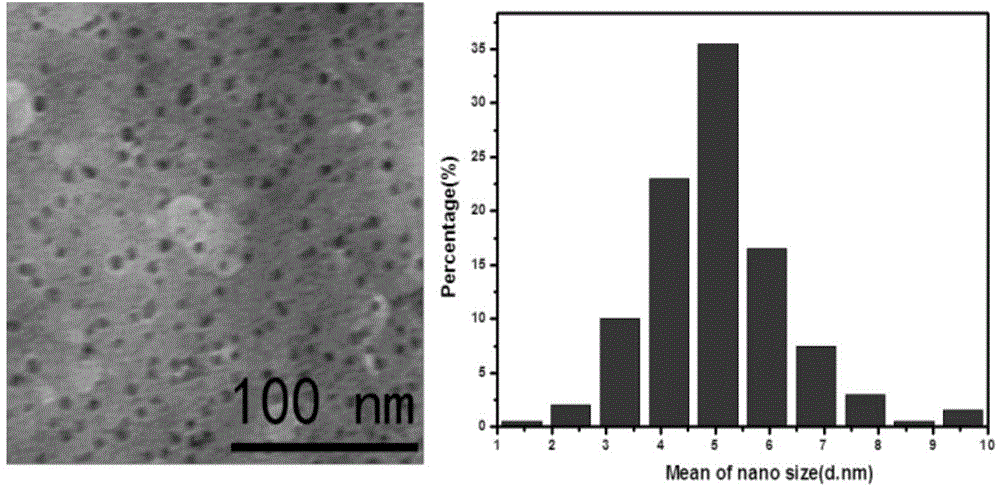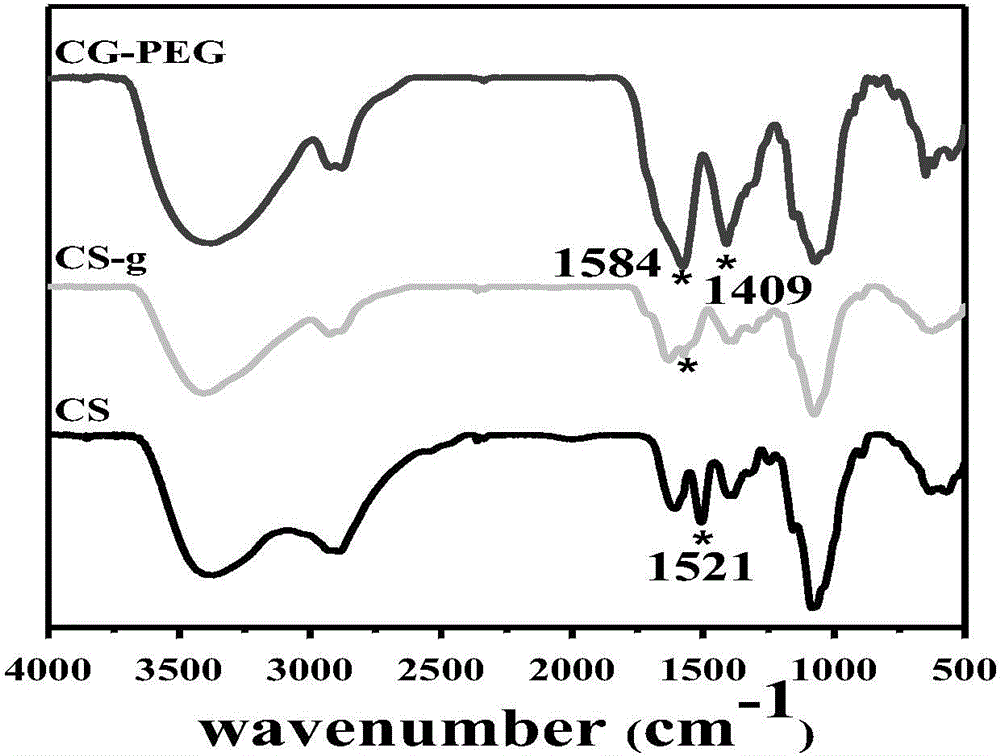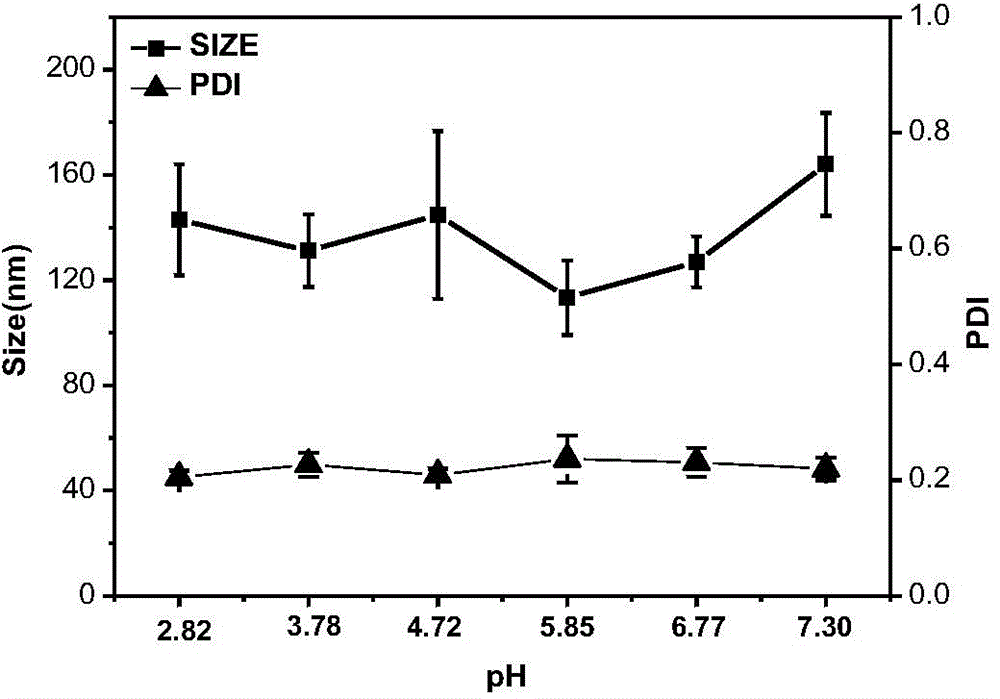Preparation method of nanoparticles with photothermal effect and application thereof
A nanoparticle and photothermal effect technology, applied in the field of nanomedical materials, can solve the problems of short half-life, irreversible degradation, loss of photothermal conversion ability, etc.
- Summary
- Abstract
- Description
- Claims
- Application Information
AI Technical Summary
Problems solved by technology
Method used
Image
Examples
Embodiment 1
[0033] Embodiment 1: Preparation of PEGylated Chitosan Genipin Nanoparticles
[0034] 1) Cyclohexane 18.15mL is the oil phase, tritonX-1004.74g is the surfactant, n-octanol 4.41mL is the co-surfactant, and mixed and stirred for 30min.
[0035] 2) Chitosan 33mg was dissolved in water and ultrasonically vortexed to form a 0.55mL solution, wherein the molar number of primary amino groups of chitosan was 0.183mmol, genipin 27mg was dissolved in 200ul ethanol, and then deionized water was added to form a 0.55mL solution, The above two solutions were first mixed and ultrasonically cross-linked for 2 minutes to prepare an aqueous phase.
[0036] 3) The aqueous phase solution in step 2) was added to the oil phase containing surfactant and co-surfactant in step 1), ultrasonicated for 10 min to form an inverse microemulsion (1), and reacted at room temperature for 12 h.
[0037] 4) 50 mg of succinimide acetate PEG was dissolved in 0.55 mL of aqueous solution, and added to the oil phase...
Embodiment 2
[0039] Example 2: PEGylated Chitosan Genipin Nanoparticles Loaded Indocyanine Green and Characterization of Its Properties
[0040] 1) Dissolve indocyanine green, a photothermal conversion material, in deionized water, and disperse it ultrasonically to form a 1 mg / mL solution. Take 1 mL of the above indocyanine green solution and add it dropwise to 1 mL of 2 mg / mL PEGylated chitosan genipin nano Microparticles, 100w ultrasonic 10min, stirred overnight 12h, using 10KDa ultrafiltration tube ultrafiltration to remove excess free indocyanine green.
[0041] 2) Transmission electron micrograph ( figure 1 ) shows that the prepared nanoparticles are spherical, with an average particle size of about 5 nanometers, all within 10 nanometers.
[0042] 3) Fourier transform infrared absorption spectrum ( figure 2 ) showed that PEG molecules were successfully modified to the surface of polysaccharide genipin nanoparticles.
[0043] 4) Dynamic light scattering analysis ( image 3 ) shows t...
Embodiment 3
[0045] Example 3: PEGylated chitosan genipin-indocyanine green nanoparticles cell killing effect
[0046] Take U87 cells 10 4 Inoculate in a 96-well plate and incubate overnight, take PEGylated chitosan genipin-indocyanine green nanoparticles and free indocyanine green and other gradient dilutions, add 10ul to DMEM medium, and form ICG with final concentrations of 4.68 and 9.375 , 18.75, 37.5, 17.5ug / mL culture solution, 5% CO 2 , incubated at 37° for 4 hours, irradiated with laser light in a 37° water bath for 15 minutes, discarded the above culture medium, washed it with PBS, added normal culture medium, and detected cell activity by MTT method. Figure 5 The results show:
[0047] 1) The polysaccharide genipin-indocyanine green nanoparticles are under no laser irradiation, when the indocyanine green concentration is 75ug / mL, the cell activity is higher than 70%, indicating that the nanoparticles are less toxic to cells; Under the irradiation of (808nm, 0.17W / cm 2 , 10mi...
PUM
| Property | Measurement | Unit |
|---|---|---|
| Wavelength | aaaaa | aaaaa |
| Particle size | aaaaa | aaaaa |
| Volume | aaaaa | aaaaa |
Abstract
Description
Claims
Application Information
 Login to View More
Login to View More - R&D
- Intellectual Property
- Life Sciences
- Materials
- Tech Scout
- Unparalleled Data Quality
- Higher Quality Content
- 60% Fewer Hallucinations
Browse by: Latest US Patents, China's latest patents, Technical Efficacy Thesaurus, Application Domain, Technology Topic, Popular Technical Reports.
© 2025 PatSnap. All rights reserved.Legal|Privacy policy|Modern Slavery Act Transparency Statement|Sitemap|About US| Contact US: help@patsnap.com



